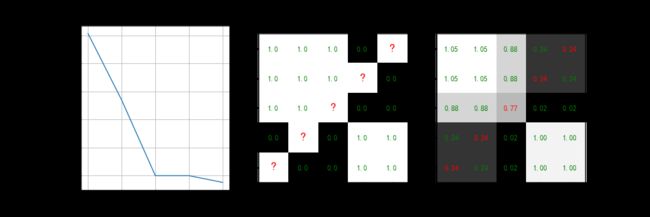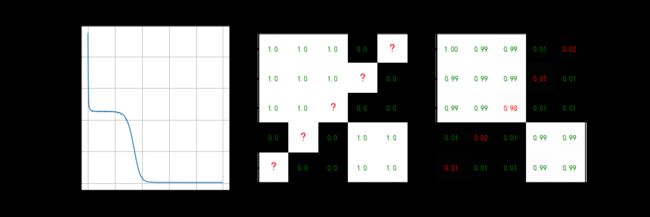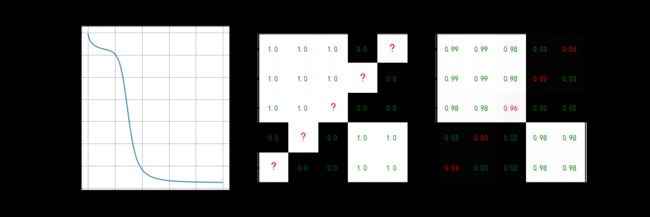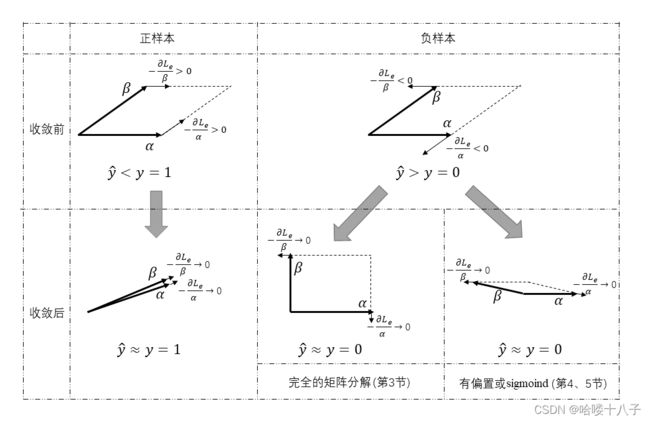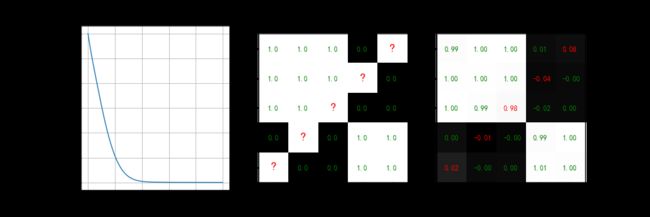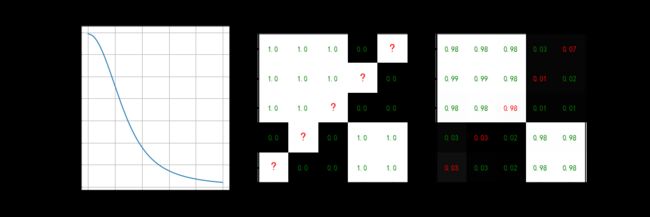推荐算法之--矩阵分解(Matrix Factorization)
文章目录
- 推荐算法之--矩阵分解(Matrix Factorization)
-
- 1. 共现矩阵
- 2. 矩阵分解(MF)
- 3. SVD实现矩阵分解(MF)
- 4. 梯度下降 实现 矩阵分解(MF)
-
- 4.1 前向推理 & 符号表示
- 4.2 损失函数
- 4.3 梯度计算
- 4.4 代码测试
- 5. 梯度下降 实现 广义矩阵分解(GMF):
-
- 5.1 前向推理 & 符号表示
- 5.2 损失函数
- 5.3 梯度计算
- 5.4 代码测试
- 6. 梯度的几何理解
-
- 6.1 误差损失函数的梯度
-
- (1)关于 用户/物品矩阵
- (2)关于 用户/物品/整体偏置
- 6.3 正则化损失函数的梯度
- 7. Keras实现
-
- 7.1 矩阵分解模型(MF,没有sigmoid,前向推理同4.1节)
- 7.2 广义矩阵分解 (GMF,有sigmoid,前向推理同5.1节)
推荐算法之–矩阵分解(Matrix Factorization)
在众多推荐算法或模型的发展演化脉络中,基于矩阵分解的推荐算法,处在了一个关键的位置:
- 向前承接了协同率波的主要思想,一定程度上提高了处理稀疏数据的能力和模型泛化能力,缓解了头部效应;
- 向后可以作为Embedding思想的一种简单实现,可以很方便、灵活地扩展为更加复杂的深度学习模型。
因此,矩阵分解模型虽然简单,但也值得深入理解和思考。
1. 共现矩阵
推荐问题中,不同人对不同物品的倾向/喜欢程度,可表示为共现矩阵,即记录某个人和某个物品共同出现的 频次/频率/概率。
例如,商品推荐|新闻推荐|视频推荐 场景中,矩阵第u行第i列的元素,可以表示第u个人对第i个商品|新闻|视频 的 购买次数|点击次数|观看时长。
直观地,假设有5个用户,5个商品,根据是否存在购买行为(买过为1,否则0),可表示为共现矩阵 Y g t Y_{gt} Ygt:
Y_gt = [1, 1, 1, 0, 0], # 用户1
[1, 1, 1, 0, 0], # 用户2
[1, 1, 1, 0, 0], # 用户3
[0, 0, 0, 1, 1], # 用户4
[0, 0, 0, 1, 1], # 用户5
其中每一行对应一个用户,每一列对应一个商品,即用户123买过商品123,用户45买过商品45。
上面的矩阵中,所有元素都是已知的,然而实际场景中,仅有少数元素是已知的,大部分位置是空缺和未知的,例如,几乎没有人买过某宝/某东商品列表中的所有商品。
因此,推荐算法的应用场景,则是对上述矩阵中存在的未知元素进行预测,例如电商场景中,预测某个用户对某个商品的购买倾向。
一个简单的例子,从上面的矩阵 Y g t Y_{gt} Ygt中“挖去”一些元素,得到如下矩阵 Y Y Y,其中问号“?”表示待估计值;
Y = [1, 1, 1, 0, ?], # 用户1
[1, 1, 1, ?, 0], # 用户2
[1, 1, ?, 0, 0], # 用户3
[0, ?, 0, 1, 1], # 用户4
[?, 0, 0, 1, 1], # 用户5
2. 矩阵分解(MF)
“物以类聚,人以群分”,购买过相同物品的人,往往有着相同的购买倾向或兴趣。
例如,根据有“空洞”的共现矩阵 Y Y Y,用户123都买过物品12,有着相同的购买倾向,同时用户12都买过物品3,于是可以推测用户3可能也会喜欢物品3.
人群的“兴趣模式”,通常少于人的个数或物品的个数,且随着人数和物品数量的增多,这种效果会越来越明显,即人群的“兴趣模式”是稀疏的;
从矩阵的角度,也不难看出,对于上面的例子,矩阵 Y g t Y_{gt} Ygt的秩只有2,小于矩阵的行数/列数,即矩阵中存在着大量冗余信息。
从谱分析的角度,矩阵分解模型相当于一个低通滤波器:通过对共现矩阵进行低秩分解,滤掉了低能量的高频信息,保留了高能量的低频信息。
3. SVD实现矩阵分解(MF)
对于小型矩阵,通过SVD的方式可简单实现矩阵分解。然而,此类方式存在一些问题:
- 不适用于大矩阵,容易爆内存;
- 需要预先对缺失值进行填充;
- 缺失值填充后会和已知数据混淆,不能区分开。
一个简单的例子如下:
import numpy as np
# 参数
num_user = 5 # 用户个数
num_item = 5 # 商品个数
latent = 2 # 隐向量维度(Embedding)
## Y_gt
Y_gt = np.array([
[1, 1, 1, 0, 0],
[1, 1, 1, 0, 0],
[1, 1, 1, 0, 0],
[0, 0, 0, 1, 1],
[0, 0, 0, 1, 1],
], dtype=np.float)
# Y
Y = Y_gt.copy()
Y[0, 4] = Y[1, 3] = Y[2, 2] = Y[3, 1] = Y[4, 0] = None
# 填充为0.5
Y_padding = np.nan_to_num(Y, nan=0.5)
# SVD分解
U, S, Vh = np.linalg.svd(Y_padding, full_matrices=True)
# 把奇异值S平分到用户矩阵P和物品矩阵Q上
P = U[:, :latent] * np.sqrt(S[:latent]).reshape(1, -1)
Q = Vh[:latent, :]* np.sqrt(S[:latent]).reshape(-1, 1)
## 最终得到的 用户矩阵P、物品矩阵Q
print('P = \n', np.around(P,2))
print('Q = \n', np.around(Q,2))
# 对Y进行重建,实现缺失值估计
Y_re = P @ Q
# -------------------------------------输出结果
# P =
# [[-0.99 0.27] # 用户/物品隐向量的 几何特征;
# [-0.99 0.27] # 用户123 & 物品123,隐向量基本同向,内积≈1;
# [-0.78 0.4 ] # 用户45 & 物品45 ,隐向量基本同向,内积≈1;
# [-0.48 -0.88] # 用户123 & 物品45 , 隐向量基本正交,内积≈0;
# [-0.48 -0.88]] # 用户45 & 物品123, 隐向量基本正交,内积≈0;
# Q =
# [[-0.99 -0.99 -0.78 -0.48 -0.48]
# [ 0.27 0.27 0.4 -0.88 -0.88]]
# -------------------------------------
这里准备一个作图的函数,简化代码,方便展示结果,后面还会用到:
import matplotlib.pyplot as plt
plt.rcParams['font.sans-serif'] = 'SimHei'
def show_result(curve, curve_name, Y, Y_re, figname, save=False):
fig, axs = plt.subplots(1, 3, figsize=(15, 5), num=figname)
axs[0].plot(curve) # 曲线
axs[0].grid()
axs[0].set_title(curve_name)
axs[1].imshow(Y, cmap='gray') # 待预测/填充数据
axs[1].set_title('待填充数据')
axs[2].imshow(Y_re, cmap='gray')# 填充/预测结果
axs[2].set_title('预测填充')
for u in range(num_user):
for i in range(num_item):
if np.isnan(Y[u,i]):
axs[1].text(u-0.1, i+0.1, '?', fontsize=20, color='r')
axs[2].text(u-0.25, i+0.1, '%1.2f'%Y_re[u,i], fontsize=12, color='r')
else:
axs[1].text(u-0.2, i+0.1, str(Y[u,i]), fontsize=12, color='g')
axs[2].text(u-0.25, i+0.1, '%1.2f'%Y_re[u,i], fontsize=12, color='g')
if save:
fig.savefig('./image/%s.png'%(figname))
调用作图函数,展示结果:
show_result(curve=S, curve_name='奇异值', Y=Y, Y_re=Y_re, figname='SVD', save=True)
可以看到,SVD后,只有两个较大奇异值,因此信息大多保留在 左/右奇异矩阵的前 2列/行中。丢掉 左/右奇异矩阵的 后3列/行,实现了低通滤波和数据重建;
4. 梯度下降 实现 矩阵分解(MF)
因为SVD求解时存在的问题,实际场景中一般不用SVD,而是采用数值迭代和梯度下降的方式,实现矩阵分解。
同时,可以为用户、物品、和用户-物品整体 各添加偏置项(有点类似batch normalization的作用),让被分解对象尽量有0均值,降低模型复杂度。
4.1 前向推理 & 符号表示
对于共现矩阵 Y Y Y的第 u u u行第 i i i列,即第 u u u个用户对第 i i i个物品的 点击率/购买概率,将模型对它的估计值记作 y ^ u , i \hat y_{u,i} y^u,i:
y ^ u , i = ∑ k = 0 K P u , k ⋅ Q k , i + p u + q i + c \hat y_{u,i} = \sum_{k=0}^K P_{u,k} \cdot Q_{k,i} + p_u + q_i + c y^u,i=k=0∑KPu,k⋅Qk,i+pu+qi+c
其中,待求解的参数集合 Θ = { P , Q , p , q , c } \Theta= \{ P, Q, p, q, c \} Θ={P,Q,p,q,c}:
P P P – 用户矩阵,共M行K列,M为用户个数。 P u , k P_{u,k} Pu,k表示其第 u u u行第 k k k列的元素;
Q Q Q – 物品矩阵,共K行N列,N为物品个数, Q k , i Q_{k,i} Qk,i表示其第 k k k行第 i i i列的元素;
p p p – 用户偏置向量,共M个元素;
q q q – 物品偏置向量,共N个元素;
c c c – 整体偏置,标量;
K K K – 相当于Embeding / 隐向量维度,通常 K K K远小于 M , N M,N M,N;
4.2 损失函数
以 y u , i y_{u,i} yu,i为真值(Ground Truth),误差损失(MSE):
L e = ∥ y ^ − y ∥ 2 = ∑ u , i ( y ^ u , i − y u , i ) 2 L_e = \|\hat y - y\|^2 = \sum_{u,i} (\hat y_{u,i} - y_{u,i})^2 Le=∥y^−y∥2=u,i∑(y^u,i−yu,i)2
正则化损失:
L 2 = ∥ P ∥ 2 + ∥ Q ∥ 2 + ∥ p ∥ 2 + ∥ q ∥ 2 + ∥ c ∥ 2 L_2 = \|P\|^2 + \|Q\|^2 + \|p\|^2 + \|q\|^2 + \|c\|^2 L2=∥P∥2+∥Q∥2+∥p∥2+∥q∥2+∥c∥2
综上,整体损失
L = L e + λ L 2 L = L_e + \lambda L_2 L=Le+λL2
4.3 梯度计算
关于损失误差 L e L_e Le:
∂ L e ∂ y ^ u , i = 2 ( y ^ u , i − y u , i ) ∂ y ^ u , i ∂ P u , k = Q k , i ∂ y ^ u , i ∂ Q k , i = P u , k ∂ y ^ u , i ∂ p u = ∂ y ^ u , i ∂ q i = ∂ y ^ u , i ∂ c = 1 \begin{aligned} \frac{\partial L_e}{\partial \hat y_{u,i}} &= 2 (\hat y_{u,i} - y_{u, i}) \\ \frac{\partial \hat y_{u,i}}{\partial P_{u,k}} &= Q_{k,i} \\ \frac{\partial \hat y_{u,i}}{\partial Q_{k,i}} &= P_{u,k} \\ \frac{\partial \hat y_{u,i}}{\partial p_u} &= \frac{\partial \hat y_{u,i}}{\partial q_i} = \frac{\partial \hat y_{u,i}}{\partial c} =1 \\ \end{aligned} ∂y^u,i∂Le∂Pu,k∂y^u,i∂Qk,i∂y^u,i∂pu∂y^u,i=2(y^u,i−yu,i)=Qk,i=Pu,k=∂qi∂y^u,i=∂c∂y^u,i=1
于是有:
∂ L e ∂ P u , k = ∂ L e ∂ y ^ u , i ∂ y ^ u , i ∂ P u , k = 2 ( y ^ u , i − y u , i ) Q k , i ∂ L e ∂ Q k , i = ∂ L e ∂ y ^ u , i ∂ y ^ u , i ∂ Q k , i = 2 ( y ^ u , i − y u , i ) P u , k ∂ L e ∂ p u = ∂ L e ∂ y ^ u , i ∂ y ^ u , i ∂ p u = 2 ( y ^ u , i − y u , i ) ∂ L e ∂ q i = ∂ L e ∂ y ^ u , i ∂ y ^ u , i ∂ q i = 2 ( y ^ u , i − y u , i ) ∂ L e ∂ c = ∂ L e ∂ y ^ u , i ∂ y ^ u , i ∂ c = 2 ( y ^ u , i − y u , i ) \begin{aligned} \frac{\partial L_e}{\partial P_{u,k}} &= \frac{\partial L_e}{\partial \hat y_{u,i}}\frac{\partial \hat y_{u,i}}{\partial P_{u,k}} = 2 (\hat y_{u,i} - y_{u,i}) Q_{k,i} \\ \frac{\partial L_e}{\partial Q_{k,i}} &= \frac{\partial L_e}{\partial \hat y_{u,i}}\frac{\partial \hat y_{u,i}}{\partial Q_{k,i}} = 2 (\hat y_{u,i} - y_{u,i}) P_{u,k} \\ \frac{\partial L_e}{\partial p_u} &= \frac{\partial L_e}{\partial \hat y_{u,i}}\frac{\partial \hat y_{u,i}}{\partial p_u} = 2 (\hat y_{u,i} - y_{u,i}) \\ \frac{\partial L_e}{\partial q_i} &= \frac{\partial L_e}{\partial \hat y_{u,i}}\frac{\partial \hat y_{u,i}}{\partial q_i} = 2 (\hat y_{u,i} - y_{u,i}) \\ \frac{\partial L_e}{\partial c} &= \frac{\partial L_e}{\partial \hat y_{u,i}}\frac{\partial \hat y_{u,i}}{\partial c} = 2 (\hat y_{u,i} - y_{u,i}) \\ \end{aligned} ∂Pu,k∂Le∂Qk,i∂Le∂pu∂Le∂qi∂Le∂c∂Le=∂y^u,i∂Le∂Pu,k∂y^u,i=2(y^u,i−yu,i)Qk,i=∂y^u,i∂Le∂Qk,i∂y^u,i=2(y^u,i−yu,i)Pu,k=∂y^u,i∂Le∂pu∂y^u,i=2(y^u,i−yu,i)=∂y^u,i∂Le∂qi∂y^u,i=2(y^u,i−yu,i)=∂y^u,i∂Le∂c∂y^u,i=2(y^u,i−yu,i)
关于正则误差 L 2 L_2 L2
∂ L 2 ∂ P u , k = 2 P u , k ∂ L 2 ∂ Q k , i = 2 Q k , i ∂ L 2 ∂ p u = 2 p u ∂ L 2 ∂ q i = 2 q i ∂ L 2 ∂ c = 2 c \begin{aligned} \frac{\partial L_2}{\partial P_{u,k}} &= 2 P_{u,k} \\ \frac{\partial L_2}{\partial Q_{k,i}} &= 2 Q_{k,i} \\ \frac{\partial L_2}{\partial p_u} &= 2 p_u \\ \frac{\partial L_2}{\partial q_i} &= 2 q_i \\ \frac{\partial L_2}{\partial c} &= 2 c \\ \end{aligned} ∂Pu,k∂L2∂Qk,i∂L2∂pu∂L2∂qi∂L2∂c∂L2=2Pu,k=2Qk,i=2pu=2qi=2c
综上,整体梯度:
∂ L ∂ θ = ∂ L e ∂ θ + λ ∂ L 2 ∂ θ \frac{\partial L}{\partial \theta} = \frac{\partial L_e}{\partial \theta} + \lambda \frac{\partial L_2}{\partial \theta} ∂θ∂L=∂θ∂Le+λ∂θ∂L2
其中, θ ∈ Θ \theta \in \Theta θ∈Θ 表示参数集合 Θ = { P , Q , p , q , c } \Theta= \{ P, Q, p, q, c \} Θ={P,Q,p,q,c} 中每个参数;
4.4 代码测试
首先准备数据集,将上面的共现矩阵 Y Y Y,转换为 ( u − i − y u , i ) \big(u-i-y_{u,i} \big) (u−i−yu,i)三元组的形式,保存为DataFrame.
## 数据集
import pandas as pd
dataset = pd.DataFrame(columns=['user', 'item', 'score'])
for u in range(num_user):
for i in range(num_item):
if np.isnan(Y[u,i]):
continue
dataset = dataset.append({
'user' : u,
'item' : i,
'score' : Y[u,i]
}, ignore_index=True)
print(dataset)
准备好的数据集(5×5的矩阵,除去5个缺失值,还剩20条数据):
user item score
0 0.0 0.0 1.0
1 0.0 1.0 1.0
2 0.0 2.0 1.0
3 0.0 3.0 0.0
4 1.0 0.0 1.0
5 1.0 1.0 1.0
6 1.0 2.0 1.0
7 1.0 4.0 0.0
8 2.0 0.0 1.0
9 2.0 1.0 1.0
10 2.0 3.0 0.0
11 2.0 4.0 0.0
12 3.0 0.0 0.0
13 3.0 2.0 0.0
14 3.0 3.0 1.0
15 3.0 4.0 1.0
16 4.0 1.0 0.0
17 4.0 2.0 0.0
18 4.0 3.0 1.0
19 4.0 4.0 1.0
为了简化代码,创建两个函数,后面还会用到:
# 初始化模型参数
def initial_para():
P = np.random.randn(num_user, latent) * 0.01 # 用户矩阵
Q = np.random.randn(latent, num_item) * 0.01 # 商品矩阵
p = np.zeros(num_user, dtype=np.float) # 用户偏置
q = np.zeros(num_item, dtype=np.float) # 商品偏置
c = 0.0 # 整体偏置
return P, Q, p, q, c
## 打印模型参数
def print_para(P=None, Q=None, p=None, q=None, c=None):
if P is not None: print('P = \n', np.around(P,2))
if Q is not None: print('Q = \n', np.around(Q,2))
if p is not None: print('p = ', np.around(p,2))
if q is not None: print('q = ', np.around(q,2))
if c is not None: print('c = ', np.around(c,2))
正式开始模型训练:
lr = 1e-2 # 学习率
lambda_l2 = 1e-2 # 正则化参数
num_epoch = 500 # 迭代次数
loss = [] # 记录loss
P, Q, p, q, c = initial_para() # 初始化模型参数
idx_shuffle = np.arange(len(dataset)) # 训练数据序号,后面会乱序读取
for epoch in range(num_epoch):
loss_err = 0.0
np.random.shuffle(idx_shuffle) # 打乱训练集序号顺序
for idx in idx_shuffle:
u = int(dataset.iloc[idx]['user'])
i = int(dataset.iloc[idx]['item'])
gt = dataset.iloc[idx]['score']
# 前向传播
score = np.dot(P[u, :], Q[:, i]) + p[u] + q[i] + c
eui = score - gt
# 误差损失(均方误差)
loss_err += eui ** 2
# 反向传播,梯度下降
P[u, :] -= lr * (2 * eui * Q[:, i] + 2 * lambda_l2 * P[u, :] )
Q[:, i] -= lr * (2 * eui * P[u, :] + 2 * lambda_l2 * Q[:, i] )
p[u] -= lr * (2 * eui + 2 * lambda_l2 * p[u] )
q[i] -= lr * (2 * eui + 2 * lambda_l2 * q[i] )
c -= lr * (2 * eui + 2 * lambda_l2 * c )
# L2正则化误差
loss_l2 = lambda_l2 * np.linalg.norm(P, ord=2) + \
lambda_l2 * np.linalg.norm(Q, ord=2) + \
lambda_l2 * np.linalg.norm(p, ord=2) + \
lambda_l2 * np.linalg.norm(q, ord=2) + \
lambda_l2 * np.abs(c)
loss.append(loss_err + loss_l2)
if epoch % 100 == 0:
print('Epoch=%03d, Loss=%1.6f, L2=%1.6f, lr=%1.6f'%(epoch, loss_err, loss_l2, lr))
模型训练完成后,对存在缺失元素的共线矩阵 Y Y Y进行重建/填充,实现缺失值预测。并展示结果。
# 预测填充
Y_re = np.matmul(P, Q) + p.reshape((-1, 1)) + q.reshape((1, -1)) + c
## 结果展示
print_para(P, Q, p, q, c)
show_result(curve=loss, curve_name='损失函数', Y=Y, Y_re=Y_re, figname='SGD_linear', save=True)
# -------------------------------------输出结果
# P =
# [[ 0.18 0.55] # 用户/物品 隐向量的 几何特征:
# [ 0.2 0.55] # 用户123 & 物品123,隐向量基本同向;
# [ 0.18 0.55] # 用户45 & 物品45 ,隐向量基本同向;
# [-0.28 -0.77] # 用户123 & 物品45 , 隐向量基本反向;
# [-0.25 -0.78]] # 用户45 & 物品123, 隐向量基本反向;
# Q =
# [[ 0.19 0.17 0.19 -0.26 -0.28]
# [ 0.55 0.56 0.55 -0.78 -0.77]]
# p = [0.2 0.2 0.2 0.03 0.03]
# q = [0.2 0.2 0.2 0.03 0.03]
# c = 0.25
5. 梯度下降 实现 广义矩阵分解(GMF):
上面的预测模型,并未对输出结果进行规范化,即将最终概率限制到0~1。
当然也可以得到预测结果后,在后面手动添加一个限制函数:
f ( x ) = min [ 1 , max ( 0 , x ) ] f(x) = \text{min} \Big[1,\ \text{max}(0,\ x) \Big] f(x)=min[1, max(0, x)]
这里尝试另一种思路,即在模型结构输出端添加sigmoid函数,让用户/物品矩阵学会适应sigmoid的非线性效果,端到端地训练模型,不对模型输出的结果做二次处理。
一般称作:广义矩阵分解(Generalized Matrix Factorization, GMF)。
5.1 前向推理 & 符号表示
添加sigmoid层后,模型输出 y ^ u , i \hat y_{u,i} y^u,i变成了:
o u , i = ∑ k = 0 K P u , k ⋅ Q k , i + p u + q i + c y ^ u , i = sigmoid ( o u , i ) \begin{aligned} o_{u,i} &= \sum_{k=0}^K P_{u,k} \cdot Q_{k,i} + p_u + q_i + c \\ \hat y_{u,i} &= \text{sigmoid} (o_{u,i}) \end{aligned} ou,iy^u,i=k=0∑KPu,k⋅Qk,i+pu+qi+c=sigmoid(ou,i)
5.2 损失函数
误差损失(用交叉熵,和sigmoid搭配,保证梯度合理):
L e = − ∑ u , i [ y u , i ⋅ log ( y ^ u , i ) + ( 1 − y u , i ) ⋅ log ( 1 − y ^ u , i ) ] L_e = - \sum_{u,i} \bigg[y_{u,i} \cdot \text{log}(\hat y_{u,i}) + (1 - y_{u,i}) \cdot \text{log}( 1 - \hat y_{u,i}) \bigg] Le=−u,i∑[yu,i⋅log(y^u,i)+(1−yu,i)⋅log(1−y^u,i)]
正则化损失同4.2节,略。
综上,整体损失(同4.2节):
L = L e + λ L 2 L = L_e + \lambda L_2 L=Le+λL2
5.3 梯度计算
关于损失误差 L e L_e Le:
∂ L e ∂ y ^ u , i = y ^ u , i − y u , i y ^ u , i ( 1 − y ^ u , i ) ∂ y ^ u , i ∂ o u , i = y ^ u , i ( 1 − y ^ u , i ) \begin{aligned} \frac{\partial L_e}{\partial \hat y_{u,i}} &= \frac{\hat y_{u,i} - y_{u,i}}{\hat y_{u,i}(1 - \hat y_{u,i})}\\ \frac{\partial \hat y_{u,i}}{\partial o_{u,i}} &= \hat y_{u,i}(1 - \hat y_{u,i}) \end{aligned} ∂y^u,i∂Le∂ou,i∂y^u,i=y^u,i(1−y^u,i)y^u,i−yu,i=y^u,i(1−y^u,i)
于是可简化为:
∂ L e ∂ o u , i = y ^ u , i − y u , i \frac{\partial L_e}{\partial o_{u,i}} = \hat y_{u,i} - y_{u,i} ∂ou,i∂Le=y^u,i−yu,i
此外,类比4.3节:
∂ o u , i ∂ P u , k = Q k , i ∂ o u , i ∂ Q k , i = P u , k ∂ o u , i ∂ p u = ∂ o u , i ∂ q i = ∂ o u , i ∂ c = 1 \begin{aligned} \frac{\partial o_{u,i}}{\partial P_{u,k}} &= Q_{k,i} \\ \frac{\partial o_{u,i}}{\partial Q_{k,i}} &= P_{u,k} \\ \frac{\partial o_{u,i}}{\partial p_u} &= \frac{\partial o_{u,i}}{\partial q_i} = \frac{\partial o_{u,i}}{\partial c} =1 \\ \end{aligned} ∂Pu,k∂ou,i∂Qk,i∂ou,i∂pu∂ou,i=Qk,i=Pu,k=∂qi∂ou,i=∂c∂ou,i=1
于是有:
∂ L e ∂ P u , k = ∂ L e ∂ o u , i ∂ o u , i ∂ P u , k = ( y ^ u , i − y u , i ) Q k , i ∂ L e ∂ Q k , i = ∂ L e ∂ o u , i ∂ o u , i ∂ Q k , i = ( y ^ u , i − y u , i ) P u , k ∂ L e ∂ p u = ∂ L e ∂ o u , i ∂ o u , i ∂ p u = ( y ^ u , i − y u , i ) ∂ L e ∂ q i = ∂ L e ∂ o u , i ∂ o u , i ∂ q i = ( y ^ u , i − y u , i ) ∂ L e ∂ c = ∂ L e ∂ o u , i ∂ o u , i ∂ c = ( y ^ u , i − y u , i ) \begin{aligned} \frac{\partial L_e}{\partial P_{u,k}} &= \frac{\partial L_e}{\partial o_{u,i}}\frac{\partial o_{u,i}}{\partial P_{u,k}} = (\hat y_{u,i} - y_{u,i}) Q_{k,i} \\ \frac{\partial L_e}{\partial Q_{k,i}} &= \frac{\partial L_e}{\partial o_{u,i}}\frac{\partial o_{u,i}}{\partial Q_{k,i}} = (\hat y_{u,i} - y_{u,i}) P_{u,k} \\ \frac{\partial L_e}{\partial p_u} &= \frac{\partial L_e}{\partial o_{u,i}}\frac{\partial o_{u,i}}{\partial p_u} = (\hat y_{u,i} - y_{u,i}) \\ \frac{\partial L_e}{\partial q_i} &= \frac{\partial L_e}{\partial o_{u,i}}\frac{\partial o_{u,i}}{\partial q_i} = (\hat y_{u,i} - y_{u,i}) \\ \frac{\partial L_e}{\partial c} &= \frac{\partial L_e}{\partial o_{u,i}}\frac{\partial o_{u,i}}{\partial c} = (\hat y_{u,i} - y_{u,i}) \\ \end{aligned} ∂Pu,k∂Le∂Qk,i∂Le∂pu∂Le∂qi∂Le∂c∂Le=∂ou,i∂Le∂Pu,k∂ou,i=(y^u,i−yu,i)Qk,i=∂ou,i∂Le∂Qk,i∂ou,i=(y^u,i−yu,i)Pu,k=∂ou,i∂Le∂pu∂ou,i=(y^u,i−yu,i)=∂ou,i∂Le∂qi∂ou,i=(y^u,i−yu,i)=∂ou,i∂Le∂c∂ou,i=(y^u,i−yu,i)
正则误差 L 2 L_2 L2和同4.3节相同,略。
综上,整体梯度:
∂ L ∂ θ = ∂ L e ∂ θ + λ ∂ L 2 ∂ θ \frac{\partial L}{\partial \theta} = \frac{\partial L_e}{\partial \theta} + \lambda \frac{\partial L_2}{\partial \theta} ∂θ∂L=∂θ∂Le+λ∂θ∂L2
其中, θ ∈ Θ \theta \in \Theta θ∈Θ 表示参数集合 Θ = { P , Q , p , q , c } \Theta= \{ P, Q, p, q, c \} Θ={P,Q,p,q,c} 中每个参数;
5.4 代码测试
模型训练:
## ================
def sigmoid(x):
return np.exp(x) / (1 + np.exp(x))
## ================
lr = 1e-2
lambda_l2 = 1e-2
num_epoch = 1000
loss = []
P, Q, p, q, c = initial_para()
idx_shuffle = np.arange(len(dataset))
for epoch in range(num_epoch):
loss_err = 0.0
np.random.shuffle(idx_shuffle)
for idx in idx_shuffle:
u = int(dataset.iloc[idx]['user'])
i = int(dataset.iloc[idx]['item'])
gt = dataset.iloc[idx]['score']
# 前向传播
y = np.dot(P[u, :], Q[:, i]) + p[u] + q[i] + c
score = sigmoid(y)
# 误差损失(交叉熵)
loss_err += -(gt * np.log(score + 1e-8) + (1 - gt) * np.log(1 - score + 1e-8))
# 反向传播,梯度下降
eui = score - gt
P[u, :] -= lr * (eui * Q[:, i] + 2 * lambda_l2 * P[u, :] )
Q[:, i] -= lr * (eui * P[u, :] + 2 * lambda_l2 * Q[:, i] )
p[u] -= lr * (eui + 2 * lambda_l2 * p[u] )
q[i] -= lr * (eui + 2 * lambda_l2 * q[i] )
c -= lr * (eui + 2 * lambda_l2 * c )
loss_l2 = lambda_l2 * np.linalg.norm(P, ord=2) + \
lambda_l2 * np.linalg.norm(Q, ord=2) + \
lambda_l2 * np.linalg.norm(p, ord=2) + \
lambda_l2 * np.linalg.norm(q, ord=2) + \
lambda_l2 * np.abs(c)
loss.append(loss_err + loss_l2)
if epoch % 100 == 0:
print('Epoch=%03d, Loss=%1.6f, L2=%1.6f, lr=%1.6f'%(epoch, loss_err, loss_l2, lr))
模型训练完成后,对存在缺失元素的共线矩阵 Y Y Y进行重建/填充,实现缺失值预测。并展示结果。
# 重建填充
Y_re = np.matmul(P, Q) + p.reshape((-1, 1)) + q.reshape((1, -1)) + c
Y_re = sigmoid(Y_re)
## 结果
print_para(P, Q, p, q, c)
show_result(curve=loss, curve_name='损失函数', Y=Y, Y_re=Y_re, figname='SGD_sogmoid', save=True)
# -------------------------------------输出结果
# P =
# [[ 1.79 0.03] # 用户/物品隐向量的 几何特征:
# [ 1.79 0.16] # 用户123 & 物品123,隐向量基本同向,线性输出o≈4,sigmoid后趋向于1;
# [ 1.8 0.1 ] # 用户45 & 物品45 ,隐向量基本同向,线性输出o≈4,sigmoid后趋向于1;
# [-2.09 -0.16] # 用户123 & 物品45 , 隐向量基本反向,线性输出o≈-4,sigmoid后趋向于0;
# [-2.09 -0.06]] # 用户45 & 物品123, 隐向量基本反向,线性输出o≈-4,sigmoid后趋向于0;
# Q =
# [[ 1.79 1.79 1.8 -2.1 -2.09]
# [ 0.15 0.05 0.1 -0.05 -0.18]]
# p = [ 0.49 0.49 -0.05 -0.27 -0.26]
# q = [ 0.48 0.48 -0.06 -0.26 -0.26]
# c = 0.08
6. 梯度的几何理解
6.1 误差损失函数的梯度
(1)关于 用户/物品矩阵
无论是4.3节的
∂ L e ∂ P u , k = ∂ L e ∂ y ^ u , i ∂ y ^ u , i ∂ P u , k = 2 ( y ^ u , i − y u , i ) Q k , i ∂ L e ∂ Q k , i = ∂ L e ∂ y ^ u , i ∂ y ^ u , i ∂ Q k , i = 2 ( y ^ u , i − y u , i ) P u , k \begin{aligned} \frac{\partial L_e}{\partial P_{u,k}} &= \frac{\partial L_e}{\partial \hat y_{u,i}}\frac{\partial \hat y_{u,i}}{\partial P_{u,k}} = 2 (\hat y_{u,i} - y_{u,i}) Q_{k,i} \\ \frac{\partial L_e}{\partial Q_{k,i}} &= \frac{\partial L_e}{\partial \hat y_{u,i}}\frac{\partial \hat y_{u,i}}{\partial Q_{k,i}} = 2 (\hat y_{u,i} - y_{u,i}) P_{u,k} \end{aligned} ∂Pu,k∂Le∂Qk,i∂Le=∂y^u,i∂Le∂Pu,k∂y^u,i=2(y^u,i−yu,i)Qk,i=∂y^u,i∂Le∂Qk,i∂y^u,i=2(y^u,i−yu,i)Pu,k
或者5.3节的
∂ L e ∂ P u , k = ∂ L e ∂ o u , i ∂ o u , i ∂ P u , k = ( y ^ u , i − y u , i ) Q k , i ∂ L e ∂ Q k , i = ∂ L e ∂ o u , i ∂ o u , i ∂ Q k , i = ( y ^ u , i − y u , i ) P u , k \begin{aligned} \frac{\partial L_e}{\partial P_{u,k}} &= \frac{\partial L_e}{\partial o_{u,i}}\frac{\partial o_{u,i}}{\partial P_{u,k}} = (\hat y_{u,i} - y_{u,i}) Q_{k,i} \\ \frac{\partial L_e}{\partial Q_{k,i}} &= \frac{\partial L_e}{\partial o_{u,i}}\frac{\partial o_{u,i}}{\partial Q_{k,i}} = (\hat y_{u,i} - y_{u,i}) P_{u,k} \end{aligned} ∂Pu,k∂Le∂Qk,i∂Le=∂ou,i∂Le∂Pu,k∂ou,i=(y^u,i−yu,i)Qk,i=∂ou,i∂Le∂Qk,i∂ou,i=(y^u,i−yu,i)Pu,k
可以看到,损失误差 L e L_e Le关于用户矩阵 P P P或物品矩阵 Q Q Q的梯度,都有着统一的形式,
可以把它描述为:
∂ L e ∂ α ∝ Δ y ⋅ ∂ ( α T β ) ∂ α = Δ y ⋅ β \frac{\partial L_e}{\partial \alpha} \propto \Delta y \cdot \frac{\partial (\alpha^T\beta)}{\partial \alpha} = \Delta y \cdot \beta ∂α∂Le∝Δy⋅∂α∂(αTβ)=Δy⋅β
其中, α , β \alpha,\beta α,β 代表 P u , k , Q k , i P_{u,k}, Q_{k,i} Pu,k,Qk,i(因为内积的对称性,两者顺序交换后仍然成立)。
该梯度形式有两个特点:
- 梯度大小:正比于损失误差 Δ y = y ^ − y \Delta y = \hat y - y Δy=y^−y,有误差时就有梯度,误差越大梯度就越大,直到没误差之后梯度才会消失;
- 梯度方向:平行于另一个矩阵(相同的行/列的行/列向量);
(2)关于 用户/物品/整体偏置
类比(1)中损失误差 L e L_e Le关于用户矩阵 P P P或物品矩阵 Q Q Q梯度的分析思路,根据4.3节和5.3节对应的梯度公式,损失误差 L e L_e Le关于用户偏置 p p p/物品偏置 q q q/整体偏置 c c c的梯度,可以统一描述为:
∂ L e ∂ b ∝ Δ y \frac{\partial L_e}{\partial b} \propto \Delta y ∂b∂Le∝Δy
其中, b b b 代表 p u , q i , c p_u, q_i, c pu,qi,c三个偏置项。
该梯度形式对应的两个特点:
- 梯度大小:正比于损失误差 Δ y = y ^ − y \Delta y = \hat y - y Δy=y^−y,有误差时就有梯度,误差越大梯度就越大,直到没误差之后梯度才会消失;
- 梯度方向:标量,不存在方向。
相比(1),理解相对简单,不再赘述。
6.3 正则化损失函数的梯度
文中使用了2范数作为正则化项,其负梯度方向为参数向量的反方向。
根据4.3节中关于 正则误差 L 2 L_2 L2梯度 的描述。正则误差 L 2 L_2 L2关于任意参数(或参数向量) α \alpha α的梯度,可以统一描述为:
∂ L 2 ∂ α = 2 α \frac{\partial L_2}{\partial \alpha} = 2 \alpha ∂α∂L2=2α
用 α \alpha α表示参数向量,用 − ∂ L 2 α -\frac{\partial L_2}{\alpha} −α∂L2表示正则化损失函数对参数向量的负梯度方向,直观理解如下图。
其中,关于1范数和0范数的实例,可作为p范数( p ≤ 1 p\le 1 p≤1)有助于得到稀疏解(即参数中大多为0)的一种直观理解,即负梯度方向 − ∂ L 2 α -\frac{\partial L_2}{\alpha} −α∂L2驱使参数向量 α \alpha α尽可能靠近坐标轴。
PS: 另一种同样直观的几何解释相对普遍,即模型参数的最优解,为损失函数等高面 和 最小范数球的切点,对于p范数( p ≤ 1 p\le 1 p≤1),范数球是凹的,所以切点很容易出现在范数球的“尖端”位置,也就是坐标轴上,因此参数向量在某些维度上为0。
7. Keras实现
上面几节,手动推导了梯度公式,实现了梯度下降。实际场景中,尤其对于复杂模型,一般直接使用相关计算框架,梯度下降可自动实现,不需要考虑内部细节。这里以Keras为例,实现了4、5节的 梯度下降矩阵分解。
首先,准备一个通用的模型函数,通过参数控制是否添加sigmoid层,后面直接调用。
## ================
def sigmoid_tf(x):
return tf.exp(x) / (1 + tf.exp(x))
## ================
def build_network(sigmoid=False):
user_id =Input([1], name='user_id')
item_id =Input([1], name='cust_id')
user_embd = Embedding( input_dim=num_user,
output_dim=latent,
name='user_embd')(user_id)
item_embd = Embedding( input_dim=num_item,
output_dim=latent,
name='item_embd')(item_id)
user_bias = Embedding( input_dim=num_user,
output_dim=1,
name='user_bias')(user_id)
item_bias = Embedding( input_dim=num_item,
output_dim=1,
name='item_bias')(item_id)
output1 = Dot(2, name='inner_product')([user_embd, item_embd])
output2 = add([output1, user_bias, item_bias])
output3 =Flatten()(output2)
if sigmoid:
output4 = Lambda(sigmoid_tf, name='sigmoid')(output3)
model = Model( inputs=[user_id, item_id],
outputs=output4)
model.compile(optimizer='adam', loss='binary_crossentropy')
else:
model = Model(inputs=[user_id, item_id],
outputs=output3)
model.compile(optimizer='adam', loss='mse')
print(model.summary())
return model
7.1 矩阵分解模型(MF,没有sigmoid,前向推理同4.1节)
# 建模
model = build_network(sigmoid=False)
# 训练
history = model.fit( x=[dataset['user'], dataset['item']],
y=dataset['score'],
epochs=1000)
loss = history.history['loss']
# 预测
u_grid, i_grid = np.meshgrid(np.arange(num_user), np.arange(num_item))
u_grid, i_grid = u_grid.T, i_grid.T
Y_re = model.predict(x=[u_grid.reshape(-1),
i_grid.reshape(-1)],
batch_size=8)
Y_re = Y_re.reshape((num_user, num_item))
## 结果
P, Q, p, q = model.get_weights()
print_para(P, Q, p, q)
show_result(curve=loss, curve_name='损失函数', Y=Y, Y_re=Y_re, figname='keras_linear', save=True)
# -------------------------------------输出结果
# P =
# [[ 0.13 0.68]
# [ 0.2 0.69]
# [ 0.28 0.69]
# [ 0.19 -0.64]
# [ 0.42 -0.59]]
# Q =
# [[ 0.35 0.76]
# [ 0.22 0.8 ]
# [ 0.13 0.77]
# [ 0.4 -0.74]
# [ 0.32 -0.74]]
# p = [[0.24]
# [0.21]
# [0.19]
# [0.23]
# [0.19]]
# q = [[0.2 ]
# [0.19]
# [0.22]
# [0.21]
# [0.24]]
# -------------------------------------
7.2 广义矩阵分解 (GMF,有sigmoid,前向推理同5.1节)
# 建模
model = build_network(sigmoid=True)
# 训练
history = model.fit( x=[dataset['user'], dataset['item']],
y=dataset['score'],
batch_size=16,
epochs=1000)
loss = history.history['loss']
# 预测
u_grid, i_grid = np.meshgrid(np.arange(num_user), np.arange(num_item))
u_grid, i_grid = u_grid.T, i_grid.T
Y_re = model.predict(x=[u_grid.reshape(-1),
i_grid.reshape(-1)],
batch_size=8)
Y_re = Y_re.reshape((num_user, num_item))
## 结果
P, Q, p, q = model.get_weights()
print_para(P, Q, p, q)
show_result(curve=loss, curve_name='损失函数', Y=Y, Y_re=Y_re, figname='keras_sigmoid', save=True)
# -------------------------------------输出结果
# P =
# [[-1.22 -1.24]
# [-1.23 -1.23]
# [-1.25 -1.23]
# [ 1.25 1.24]
# [ 1.17 1.16]]
# Q =
# [[-1.3 -1.26]
# [-1.58 -1.65]
# [-1.6 -1.61]
# [ 1.74 1.68]
# [ 1.72 1.68]]
# p = [[ 0.47]
# [ 0.5 ]
# [ 0.08]
# [-0.66]
# [-0.14]]
# q = [[ 0.49]
# [-0.15]
# [-0.38]
# [ 0.32]
# [ 0.33]]
# -------------------------------------
